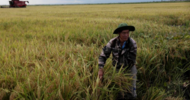By Isabel Gorst in Nizhny Novgorod, Russia
“We have had almost no rain for three months,” says Vladimir Kochetkov, a manager at one of the biggest state-owned farms in Nizhny Novgorod, in the heart of European Russia.
“There has not been such a long drought here for more than one hundred years,” he adds, with an air of resignation. The grain crop at the 8,000 hectares of farmland he manages has been halved by the lack of rain.
He is not alone in facing a ruined crop. In the area around Nizhny Novgorod, about 400km east of Moscow, officials fear the grain harvest will drop to 600,000 tonnes, less than half last year’s 1.4m. “It’s a disaster,” says Alexander Efremtsev, at the Nizhny Novgorod Grain Union.
Hot summers are not unusual in Russia’s grain belt, which stretches from the Black Sea to Siberia and enjoys some of the world’s most fertile soil.
This year, a severe heat wave and drought have destroyed the country’s grain crop, pushing farmers to the brink of bankruptcy and exposing the fragility of world food supplies. Prices of everyday food staples including bread are likely to jump as a result.
Global wheat prices soared this week on news of the deteriorating Russian harvest. European milling wheat has surged 80 per cent in the last six weeks alone, stirring memories of the 2007-08 food crisis. The acute shortage of supplies and fears of even steeper rises in wheat and food prices spurred the Kremlin on Thursday to announce an export ban on grains until the end of the year.
The ban, which surprised traders and food companies, set wheat markets on fire. In Chicago, US wheat hit an intraday high of $8.41 a bushel on Friday, up more than 25 per cent on the week and, excluding the 2007-08 food crisis, a record high.
The prices of other crops, from corn and soyabean to rapeseed and barley, used to make beer, have also jumped sharply. This wider rally reflects not just the direct impact of the drought on these commodities, but the risk that lower supplies of wheat, which is also used to feed livestock, will lead to higher demand for alternative animal feed such as corn.
The panic buying comes as traders predict Russia’s exports will drop to just 3m tonnes – the total shipments that left the country before the export ban – far below the 18m tonnes it sold overseas last year, worth $2.7bn, after a bumper crop.
Luke Chandler, grains analysts at Rabobank in London, says the sudden shortfall in global supplies coincides with Russia’s rise to prominence as an important exporter, particularly for North Africa and Middle East countries, which, he says, are “becoming increasingly reliant on Russia”.
Importing countries and food companies will now have to rely on wheat from the European Union, the US, Australia and Argentina. Traders and analysts say there are enough stocks to bridge the gap left by Russia, but no safety cushion. In other words, the weather between now and the harvest in Australia in December needs to be perfect.
The long-term consequences of the drought and the export ban remain unclear. Analysts, though, point out that the Black Sea region is well known for its volatile grain production. It was a drought in the same area that triggered sweeping grain purchases by the Soviet Union in 1972, an episode that became known as the “Great Grain Robbery”. Moscow corralled all exportable supplies for the US.
This year’s crop failure marks a major setback for the Kremlin, which is carving a role for Russia as a global grain power. Dmitry Medvedev, Russian president, has set a goal to double its grain exports by 2020 and challenge US supremacy.
The US exports half the world’s corn, a third of its soyabeans and a fifth of all wheat, making America the powerhouse of agricultural markets.
Agriculture is one of four industries being prioritised by the Kremlin as it tries to overturn the disastrous legacy of Stalin’s collectivisation. A decade ago Russia depended on US wheat imports to feed itself, but government reforms, including a law allowing foreigners to buy land, have boosted interest in farming.
Grain harvests have risen steadily since 2000, driven by more generous state subsidies and growing Russian and foreign investment in farming and food processing. There is room for more – Russia is one of the only countries in the world with the potential to increase sharply grain production. According to the World Bank, the country could double its annual harvests if farming methods were modernised and idle land put to use.
Analysts and farming executives say the crisis is likely to accelerate the consolidation of Russian agriculture already under way, allowing big conglomerates to swoop on struggling small farmers.
Black Earth Farming, an international company farming in Russia, says its winter harvest is down 44 per cent but that it will keep investing. “We are here for the long term. This is a tough year but it will not scare us off,” says Gustav Wetterling, its head of investor relations.
Dmitry Rylko, the director of the Moscow-based Institute for Agricultural Market Studies, says the failed harvest, while creating “tremendous difficulties”, is unlikely to lead to an exodus of investors. “Russia is extremely promising for agriculture,” he says. “We have been lucky with the harvest for almost ten years. Crop failures happen everywhere from Argentina to Brazil and Ukraine.”
Additional reporting by Javier Blas in London












